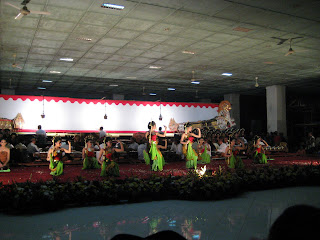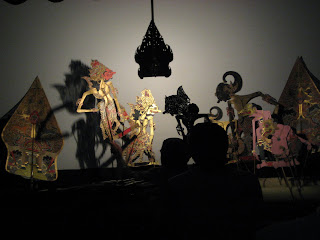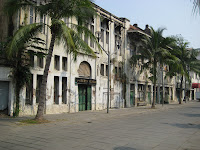
This story is a Javanese episode based on the Mahabharata and has been part of the Javanese story for many generations. The story is quite complicated and requires some background knowledge of the whole, or previous episodes, thanks to Kitsie I got a good synopsis of what would be happening and was able to follow Pak Purbo's performance.
Pak Purbo is quite spectacular and awe inspiring. His puppet manipulation is graceful and vibrant. His passion comes through in his voice and his beautifully expressive face. I had the privilege and honor of being close enough to see his hands and face throughout the performance. And even when the puppets were in dialogue (not moving) I was mesmerized by his expressive voice and face somehow having an understanding of the story without actually understanding the language. I realized watching him how important the voice of the dalang really is. His voices for the characters all have a special quality. His singing was lovely. And his passion really comes through in his voice and his attentiveness to the characters. It really seemed he was in character, or multiple characters, switching back and forth with ease like a talented actor.

He is a more traditional dalang and is charismatic, passionate and funny as he performs. He plays off as well as with the audience, the singers and other "special " people in attendance. During the first comedic interlude he proceeded to interview me while Kitsie translated. He asked me why I am interested in wayang and what I feel is important about it to bring back to America. I felt like he went on and on mentioning "Mbak Melissa" and America and New York city, but am still not completely sure what he was talking about. He also had Kitsie and Marc play gamelan during this portion. He also mentioned Pak Tristuti who was in attendance that evening as well. During the second comedic interlude he seemed a little flirtatious and commonly a dalang will flirt with the singers. I was told Mas Purbo always flirts with the singers and its really fun as he has a good sense of humor. And in flirting with one singer, they were going back and forth, they mention me and then the singer turns around and says "Mbak Melissa I would like to tell you that Mas Purbo loves you" and then that turned into this whole comedic thing going back and forth between he and I. And then he asked me to sing. So, I did my best rendition of "La Cucaracha". Singing is really embarrassing for me so I did the one thing I can't mess up and requires no singing voice. He had fun with it and the puppets did a little cucaracha dance. It was recorded and I will be getting a copy so we'll get to see the whole 8 hour show with my 5 minutes some day. The performance continued well into the morning and by that time only a few die-hard audience members were left.
































